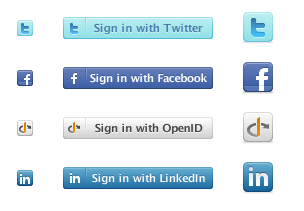Site owners, administrators, web business owners, content producers, and everyone in between, are always trying to find the best ways to encourage visitors to spend more time on their sites. It’s hard enough getting people there in the first place, but keeping visitors and customers on the site once there? No walk in the park. Just ask Groupon.
Again, sites can live or die based on engagement. And as one might expect, there are a thousand ways to increase engagement, and there’s obviously been a lot of noise around social as a great facilitator of a stickier (and more enjoyable) user experiences for websites, apps, and businesses. Approaches to making sites and apps more “social” vary — whether it’s by focusing on creating more sharable content, adding comment sections, forums, etc., or by adding re-tweet buttons, “like”, or share buttons, etc. to encourage visitors to share on their social networks of choice.
Thanks to some research (and a nifty infographic) from Gigya, the makers of SaaS technology (or a social CRM platform, if you will) that helps businesses make their websites social, we now have further proof that one of the best ways to encourage repeat visitors is through social logins.
As it has proliferated across the Web, Facebook Connect has been able to let people carry their social graphs with them wherever they go. Now, thanks to Facebook, my friends are no longer confined to the social network, they’re in my movie recommendations, check-ins, and everywhere else. In some ways, it’s pretty invasive, and in most other ways, it makes our experiences better. Take friendsourced recommendations.
As Gigya’s data shows, site owners that incorporate Facebook Connect, Twitter sign in, etc. stand to benefit: Users spend 50 percent more time on sites when they’re logging in through social networks – that’s four more minutes with a social login than with a standard login. Gigya’s data considered the Web, mobile web, and apps.
This is true of page views, too. Users logged in with a social network view twice the amount of pages. Naturally, it seems to follow that when a person logs into a site through their social network, they want to interact with the site with their social graph in tow – and, according to Gigya – is in turn acting as a gateway for user engagement through comments, sharing, game mechanics, and activity feeds.
Want to leave a comment? Sign in through your social network. TechCrunch commenters might be familiar with this one.
And with 800 million users, it’s not surprising that Facebook is the most popular provider or source of social logins, at 61 percent, followed by Yahoo at 15 percent, Google at 12 percent, Twitter at 10 percent, and LinkedIn at 2 percent. While second place is distributed, it does show that there’s probably some worth in providing more than a Facebook login option, though you’ll obviously reach the majority of users that way.
In terms of social plugins, users who interact with commenting systems generally spend the most amount of time on the site, with the same holding true for page views. So, add a comment section. You may come to regret it, but the numbers don’t lie, it increases the amount of time people spend on your site. Second? Newsfeed.
But, without further ado, I’ll let Gigya take it from here. For more, check out Gigya’s blog post here.
Infographic below:
Excerpt image from Kokomedia

